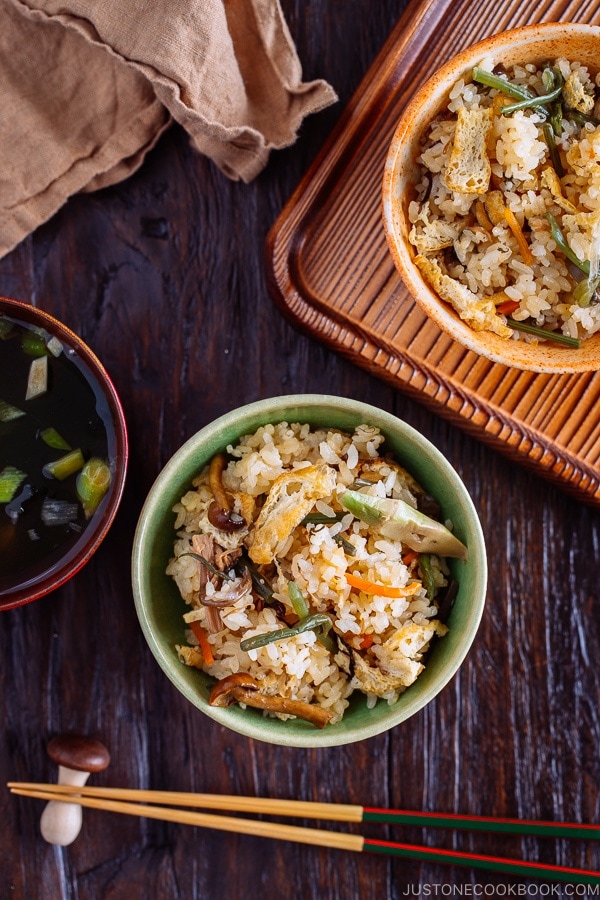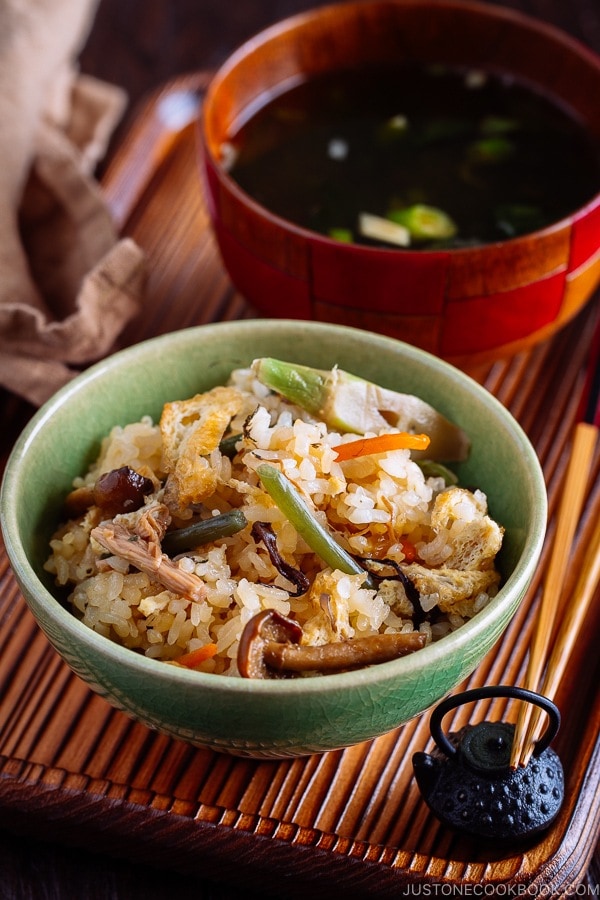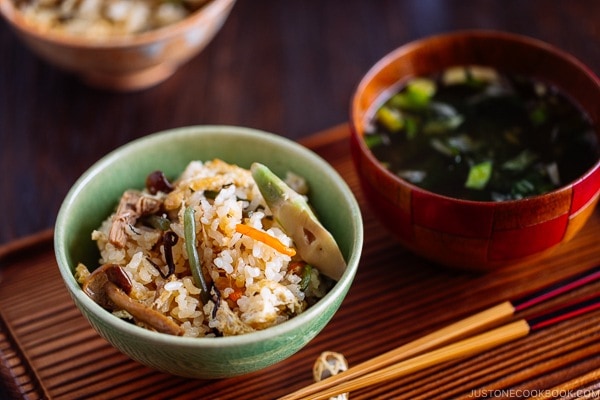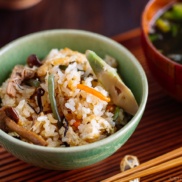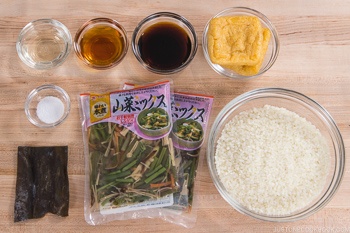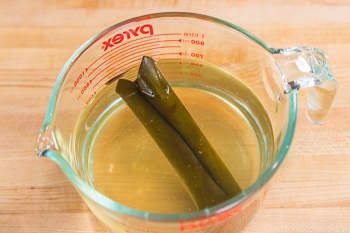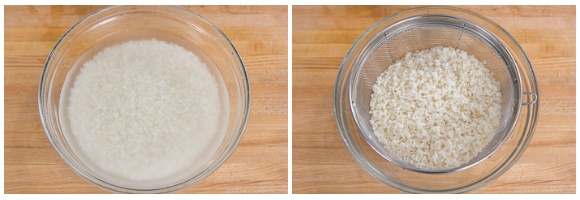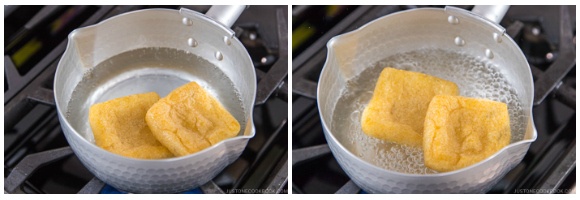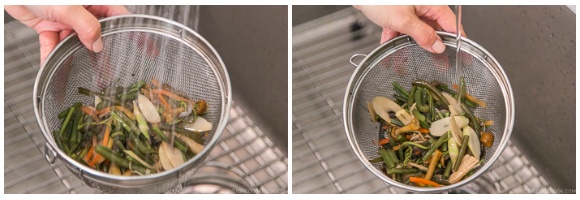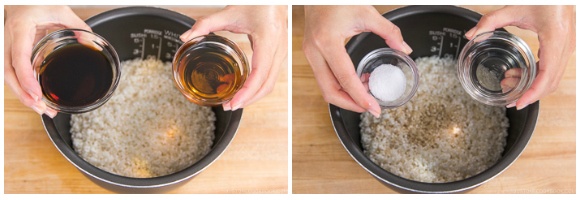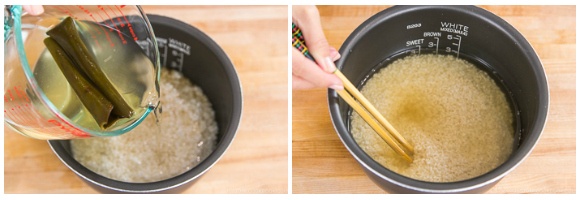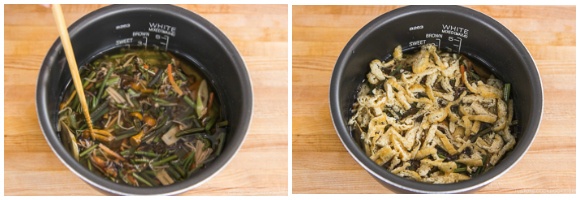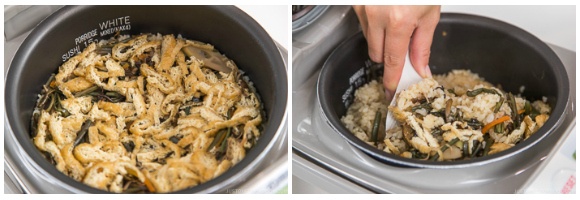Living in the mild California climate, I miss the colorful changes during the four distinct seasons in Japan, from foliage in fall to cherry blossoms in spring. I also miss the seasonal changes in ingredients. When sansai (山菜) or mountain vegetables are in grocery stores in Japan, you know that spring is just around the corner. Although we don’t get that well-defined seasonality here, I always use cooking as a way to enjoy seasonal changes. And you know when it’s spring in my kitchen; you find me preparing a bowl of Sansai Gohan (山菜ご飯).
What’s Sansai Gohan?
Sansai Gohan (山菜ご飯) or Rice with Mountain Vegetables is rice that is cooked with sansai – literally meaning “mountain vegetable.” The rice is slightly seasoned with kombu, soy sauce, sake, and mirin, but the flavors mostly come from the assorted mountain vegetables.
Sansai – Mountain Vegetables
Sansai are the edible buds and shoots of plants that are found in the wild. These wild shrubs and herbs are foraged in early spring, before they get too tough to eat. Some even start to pop up before the snow melts! They are fresh, succulent, and tender, and have very distinctive flavors. Treasured as the gifts of spring, these wild vegetables are extremely nutritious and high in medicinal properties. You can enjoy them raw, boiled, deep-fried as tempura, pickled and many other cooking methods. Here are some of the popular sansai varieties:
fuki (butterbur stalks) fuki no tou (flower buds of butterbur) kogomi (ostrich fern) seri (Oenanthe javanica, part of the parsley family) takenoko (bamboo) tara no me (young shoots of the Japanese Angelica tree pant, considered “the king of wild vegetables”) warabi (bracken fiddleheads) zenmai (flowering fern top, more prized than kogomi or warabi)
Although sansai refers to wild vegetables foraged in the mountain, in recent years, some sansai varieties have been cultivated and farm-grown.
Popular Japanese Sansai Dishes
When you visit Japan, you will likely to see these popular sansai menus in Teishoku (pre-set meal) restaurants and noodle shops.
Sansai Gohan (山菜ご飯) Sansai Soba/Udon (山菜そば・うどん) Sansai Tempura (山菜天ぷら)
You may also find sansai in shojin ryori (精進料理, vegetarian devotion cuisine) served at many Buddhist temples, especially in Kyoto.
Where to Find Sansai – Mountain Vegetables
You can buy “sansai mix” in Japanese grocery stores. They are pre-cooked and come in a bag filled with water, so they need to be refrigerated. I haven’t really looked for the vegetable mixture in Korean or Chinese grocery stores, so I’m not sure of the availability (Let me know if you find it there). The mix includes variations of the sansai mentioned above, along with mushrooms and carrots etc. All the sansai in the bag are pre-cooked, so all you need to do is to drain, and they are ready to use.
Substitute and Tips for Sansai Gohan
Kombu: This umami rich seaweed/kelp is the base of the flavor component in this seasoned rice. You can use other type of dashi, but to achieve the “authentic” Japanese taste, kombu dashi is the key. I don’t recommend using chicken stock in this recipe, for example. Sansai: The vegetable mix is the most difficult one to find for this recipe. But it is the main ingredient, and by substituting it, it basically becomes a different dish. If you’re curious to try, I recommend trying my other mixed rice recipes like Takikomi Gohan, Ginger Rice, Sweet Onion Rice, and Gobo & Miso Takikomi Gohan. Aburaage: You may notice that I include aburaage in most of my mixed rice recipe and there’s a good reason for that. The oil from the deep-fried tofu pouch gives amazing savory flavor without the addition of meat. When you’re making a dish with a simple layer, especially a vegetarian dish, toss in some aburaage can help to heighten the textures. I am also aware that this ingredient is much harder to find than Inariage, which is the seasoned tofu pouch often used for Inari Sushi. If you are going to use Inariage, remember it’s very sweet, so you have to adjust the seasonings. Usukuchi Soy Sauce: This light-colored soy sauce is actually saltier than regular soy sauce. In Kansai region of Japan (Osaka and Kyoto area), light-colored soy sauce is used to preserve the original color of the foods. You can use regular soy sauce for this recipe, but remember it’s slightly less saltier than usukuchi soy sauce. Sake & Mirin: If you want to learn more about these two essential Japanese condiments, please click here. Kosher salt: I often receive questions why I add salt when soy sauce is already included. Well, both salt and soy sauce actually play different roles. Soy sauce is used to lend a savory profile, while salt is to enhance the overall flavor of the dish. When you are doing the final tasting of the dish, you can just adjust the amount of salt to boost the flavor without adding more soy sauce. With a hint of woodsy and earthy flavor, Sansai Gohan is a rustic dish that reminds me what a special time of year spring is. To enjoy, serve this mixed rice with a bowl of miso soup.
Don’t want to miss a recipe? Sign up for the FREE Just One Cookbook newsletter delivered to your inbox! And stay in touch with me on Facebook, Google+, Pinterest, and Instagram for all the latest updates.

